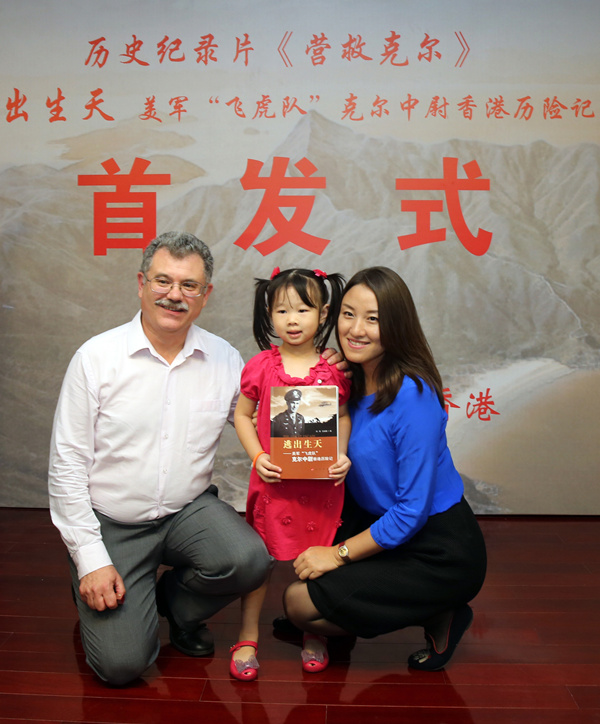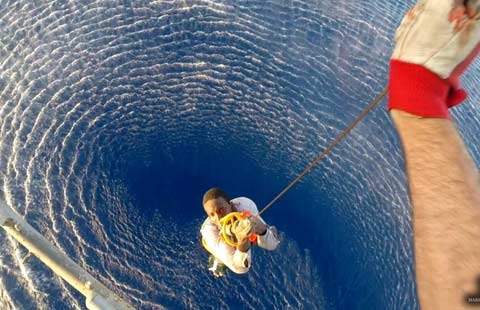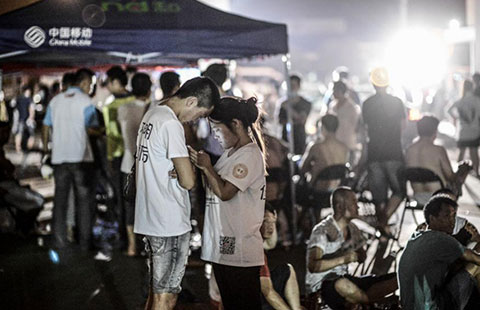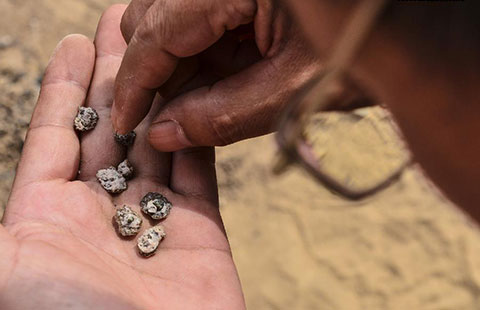US pilot is remembered in book, film
Updated: 2015-08-17 23:17
By Li Xinyi in Beijing and ZHANG YI in Kunming(China Daily USA)
|
||||||||
 |
|
David C. Kerr (left), son of Flying Tigers pilot DonaldW. Kerr, poses with descendants of Chinese WorldWar II veterans during a documentary and book launch in Beijing on Friday. JIANG DONG / CHINA DAILY |
Story of cooperation centers on hero rescued after bailing out over Japanese stronghold
A documentary and a book in Chinese recounting the exploits of a US fighter pilot who parachuted to safety in Hong Kong after shooting down a Japanese warplane during World War II will ensure that his heroic deeds are not lost to posterity.
The documentary film and book, released on Aug 14, are based on the true story of Lieutenant Donald W. Kerr, who served in the US army's 14th Air Force — partly formed from the remnants of the legendary "Flying Tigers" squadron.
He was rescued by local people after he jumped out of his P-40 fighter plane on Feb 11, 1944, when Japan's military controlled a large area of China.
"My father would be so happy that we are here to celebrate the launch of this documentary and book," said David C. Kerr, the elder Kerr's second son, at a launching ceremony held in Beijing.
"He took great pride to serve in the Chinese-American Composite Wing of the United States 14th Air Force. Every day, American and Chinese pilots and ground crews would fight together against our common enemy.
"In Hong Kong, he discovered even more of the spirit of China. Villagers and the Hong Kong-Kowloon Independent Brigade of the East River Column took great risks leading my father to safety — hiding him for several weeks and moving him by night across land and sea."
In 1944, the Chinese that fought alongside the pilot all worked together to bring him to safety, the younger Kerr said, adding that in the 21st century, many more people have worked together further to support the documentary so that the story of cooperation in 1944 will be known to future generations.
Kerr's plane was among 20 P-40 fighter planes and 12 bomber aircraft whose mission was to bomb Hong Kong’s Kai-Tak Airport, which had become a Japanese air base after the city fell on Dec 25, 1941.
After he shot down a Japanese plane, three enemy planes attacked. Kerr's aircraft was hit and caught fire near the airport.
As he later wrote in his memoir, "pictures flashed through my mind like that of a drowning man".
Rather than falling to the ground at Kai-Tak to "a circle of angry J-boys", Kerr bailed out of his plane and parachuted into the mountains to the north of the airport, aided by a southern wind, according to the memoir.
About 1,000 Japanese ground troops searched for him for about two weeks, but in vain.
The memoir, which will be published in a couple of weeks in English, is believed to have been written in the days immediately following the pilot's rescue.
It was first discovered by his son in 1982, five years after Kerr's death at the age of 62.Series of events
On Aug 13 in Kunming, US Ambassador to China Max Baucus participated in events remembering the Flying Tigers.
"I'm worried that too few Americans remember that history today. Memories fade," he said.
"So I think it's very important to do anniversaries to make more people know the joint cooperation between two countries symbolized by the Flying Tigers."
Contact the writers at zhang_yi@chinadaily.com.cn and lixinyi@chinadaily.com.cn

 In pictures: Life near Tianjin blasts site
In pictures: Life near Tianjin blasts site
 The world in photos: Aug 10-16
The world in photos: Aug 10-16
 In the face of chaos, people persevere
In the face of chaos, people persevere
 Top 10 most expensive office markets in the world
Top 10 most expensive office markets in the world
 Times Square 'Kiss-In'
Times Square 'Kiss-In'
 School turns into place of shelter in Tianjin
School turns into place of shelter in Tianjin
 Earliest site of coal fuel found in Xinjiang
Earliest site of coal fuel found in Xinjiang
 Top 10 Chinese cities with highest property prices
Top 10 Chinese cities with highest property prices
Most Viewed
Editor's Picks

|

|

|

|

|

|
Today's Top News
US pilot is remembered in book, film
'Window' on WWII opens in Bay Area
Sodium cyanide in Tianjin to be collected, neutralized
Premier Li pledges thorough investigation into deadly blasts
Experts say J-10s would benefit Iran
Indonesia rescuers head to mountains in missing plane search
New York event marks war anniversary
Li, 24, runs for House
US Weekly

|

|





